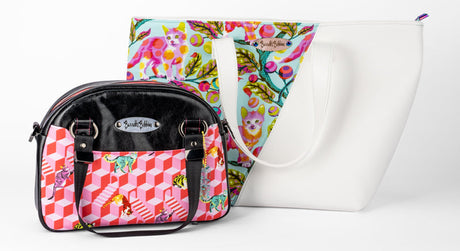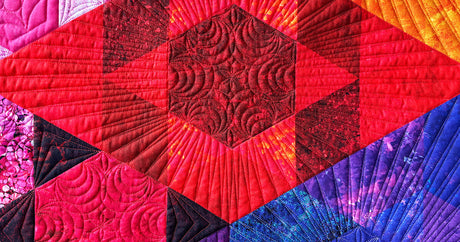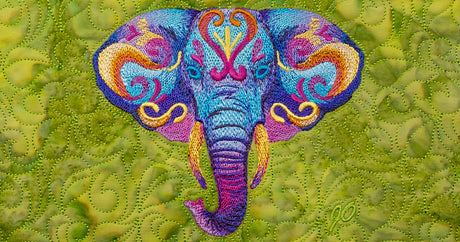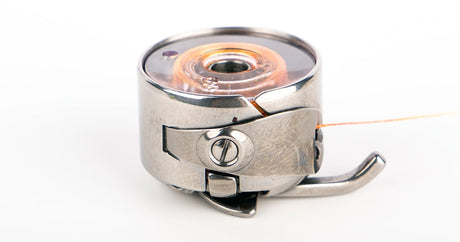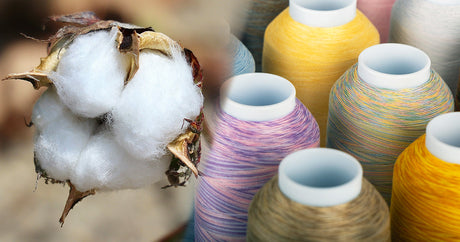Why Does Balanced Tension Matter When Quilting?
Balanced tension is the key to beautiful, durable stitches. In the simplest terms, it means your top and bobbin threads are aligned so they meet perfectly in the middle of your quilt sandwich. This guide will show you how to adjust your bobbin tension, troubleshoot common quilting tension issues, and fine-tune settings when quilting with various types of threads, including cotton, polyester, nylon, and decorative and delicate threads.
When tension is set correctly, every stitch locks into place, and your seams lie flat. This makes your quilt ready for any occasion, whether it's for a quilt show or a picnic with the grandkids. Adjusting your machine's tension may seem overwhelming or even against the rules, but it's the key to unlocking your machine's potential and endless fun with all types of threads. Properly balanced tension is important for weak and delicate threads, as well as for strong and durable ones. The highest-quality cotton threads, for example, benefit from properly dialed-in tension, the correct needle (matched to the thread weight), and high-quality fabrics.
What Does Balanced Tension Mean?
Balanced stitches not only look aesthetically pleasing, but they also last longer. We have many terms for balanced tension, including even stitches, smooth stitches, adjusted tension, equal tension, and correct tension. These terms describe the same trait of having the threads properly balanced in your quilt sandwich. When the top and bottom (bobbin) threads are synced and the tension is correct, your seams hold firmly through years of use and many washings. For quilts meant to be used and endure a lot of love and attention, balanced stitches are critical. A quilt stitched with balanced tension will feel smoother and drape more evenly.
A balanced stitch will have the top thread visible only on the top and the bobbin thread visible only on the bottom. If you flip your fabric over, both sides should show neat, even stitches without loops or puckering. The exact stitch point, in the middle of the quilt sandwich, should be neatly hidden. Think of your top and bobbin threads as dance partners performing the waltz. When both dance partners move in sync, each step lands exactly where it should, creating a smooth, graceful flow. However, if one partner leads off-tempo or lags (the top thread in this analogy), the dancers are out of sync and the performance suffers.
How to Spot and Fix Tension Problems
Once you've selected which threads you will be using in your quilt, stitch on a scrap piece of fabric to test your machine's current tension settings. If the bobbin thread is visible on top and the fabric looks puckered or wrinkled, the top tension is too tight. If the top thread is looping or showing on the bottom, the top tension is too loose. These issues aren't just cosmetic; poorly balanced stitches can weaken your seams over time, especially on quilts that will be washed and used frequently.
Most home sewing machines have a numbered tension dial ranging from 0 to 9. The middle settings, often 4 or 5, are factory defaults. On computerized machines, tension settings are typically adjusted through the screen controls. To reiterate, if you see your top thread looping on the underside of the scrap fabric, turn the dial to a higher number, increasing the tension. If the bobbin thread is pulling to the top, lower the number to decrease the tension. Make minor adjustments and test after each change.
A quick tip to save time is to loosen your machine's top tension all the way down to 1.0, then slowly increase it as you stitch until the stitches look balanced. This method helps you find the right setting more quickly than making tiny changes and checking each time.

Loosening the top tension on a sewing machine from 5-to-1.
When and Why to Adjust for Cotton Quilting Thread
Cotton quilting threads, especially extra-long staple varieties like Dream Seam and Majestic, tend to run smoothly through all well-maintained machines, but even the highest-quality threads benefit from proper settings. A heavier 40 wt. cotton may require different tension settings compared to finer 50 wt cotton used for piecing your quilt blocks together. If the tension is set at 5 and it is putting pressure on your 40 wt. Remember that machines with electronic or computer-controlled tension aren't smart enough to understand the fiber and weight of the thread you're using. "Auto tension" is merely a starting point and not a replacement for manually adjusting your machine's tension settings to achieve the optimal level of tension.
Longarm quilters will notice tension problems more noticeably, especially when switching between fiber types, such as cotton to polyester, polyester to cotton, cotton to nylon, and nylon to polyester, as well as different weights, including 40 wt. to 50 wt., ultra-fine to 50 wt., and 60 wt. to 40 wt. Test stitch your threads on a sample sandwich before starting the quilt. Testing on the basting fabric is often a quick way to dial in tension and can save you many hours of unpicking.
Polyester and Nylon Quilting Threads
Polyester and nylon quilting threads bring strength, sheen, and versatility to a wide range of quilting styles. High-sheen trilobal polyester threads, such as our Elite, create vibrant, eye-catching stitches that add dimension to your quilting designs, while low-lint 50 wt. multifilament polyester threads, such as Perfection, blend into the fabric for a softer finish. For nearly invisible stitching, Wonder Invisible Thread is our nylon monofilament. This thread allows the fabric and overall quilt design to take center stage, making it ideal for stitch-in-the-ditch and appliqué.
Because these threads differ in weight, fiber, and surface texture, they will require different tension adjustments when switching between them. Trilobal polyester often stitches well at a slightly looser tension to avoid flattening its sheen, while very-fine monofilament threads work best at drastically lower tensions, such as 1.0 on home machines. Just as with cotton threads, longarm quilters should test these threads on a fabric sandwich before beginning, as fiber type and thickness (weight) can make tension differences more apparent when topstitching a quilt top. Testing on basting fabric is a quick way to fine-tune your settings before you start working on the quilt top.

The top tension is too loose, causing the top thread to loop on the bottom of the quilt. Increasing the top tension in small increments will help you dial in the correct tension setting, making the loops disappear.

When you match the needle size to the thread weight, you minimize any additional tension caused by increased friction. Using a Topstitch #90/14 needle with a 40 wt. thread gives the thread plenty of room to move in the needle's groove and eye.
Matching Needle Size, Fabric Type, and Thread Weight
Tension isn't just about turning a dial or screwing a tensioner spring tighter. The needle needs to match the weight of the thread, or additional stress and tension will be added as the stitch is formed. A 50 wt cotton thread pairs well with a size #80/12 topstitch needle, while a 40 wt cotton works best with a #90/14. Using a needle that is too small for the thread can cause extra friction, making the tension appear too tight and sometimes causing thread breaks or fraying. Using a needle that is too large can result in loose stitches or exaggerated needle holes. You can shop our topstitch needles here and learn more about why we love this specific needle style.
Fabric type also matters. Lightweight fabrics, such as silk, often require lower tension to avoid puckering. However, heavier fabrics like denim or canvas (or, in some cases, tightly woven batiks) typically require more tension to pull the threads snugly into the layers. If you work with a wide variety of fabrics, test your tension each time you start a new project.
Mixing Thread Types and Preventing Tension Problems
It's common for quilters to use one type of thread on top and a different kind in the bobbin. For example, you might pair a 40 wt cotton on top with a 60 wt polyester, such as Precision, in the bobbin. Using threads of different weights can be one way to reduce bulk or presence at the seam and blend into the fabric. When mixing thread types, expect to make tension adjustments to keep both sides looking even.
Preventing tension issues often comes down to proper machine care and the use of high-quality fabrics, needles, and threads. Keep your machine clean, especially around the bobbin case. Lint from cotton threads can accumulate over time, affecting how the thread moves through the thread path, including between the tension discs. Use high-quality threads to minimize lint and reduce skipped stitches. If you're new to adjusting tension, write down the settings you use for different threads and fabrics so you can quickly return to them later.
If you prefer stitches that blend into the fabric, match the thread color closely to the colors of the quilt top and backing. For a bolder effect, choose a contrasting thread color or a variegated thread. Keep in mind that contrasting color(s) will show off your topstitching.
Key Takeaways for Achieving Balanced Tension
- Balanced tension means top and bobbin threads meet inside the fabric layers, creating smooth, even stitches.
- Needle size, thread weight, and fabric type all affect tension; matching them correctly is key to preventing loops, puckers, and uneven stitches.
- Testing on scrap fabric before quilting, making small tension adjustments, and keeping the machine clean helps maintain consistent results.
- Cotton, polyester, and nylon threads each behave differently, so test and make adjustments as necessary when switching between fibers or weights.
Bringing It All Together for Your Best Quilts Yet
Balanced tension is a skill that every quilter can master, even beginners! It starts with using high-quality threads, needles, and fabrics. Starting with good products is a game-changer and will do more for your stitching success than any tips and tricks.
We hope you will review the steps above often, loosening or tightening your tension to find the perfect balance. The more you practice, the quicker you'll discover that sweet spot where every stitch looks perfect.
About YLI's 40 wt. Majestic Quilting Thread
For machine quilting, our 40 wt. Majestic thread is genuinely exceptional. Made from 100% Egyptian-grown extra-long staple cotton, this thread is available in forty-five variegated colors and five solid colors. Bold and ready to enhance any quilt with eye-catching motifs, filigree, feathers, or edge-to-edge designs. Majestic is one of our premium cotton quilting threads, available in 2,000-yard cones and 600-yard spools.
Get inspired by Majestic colors


